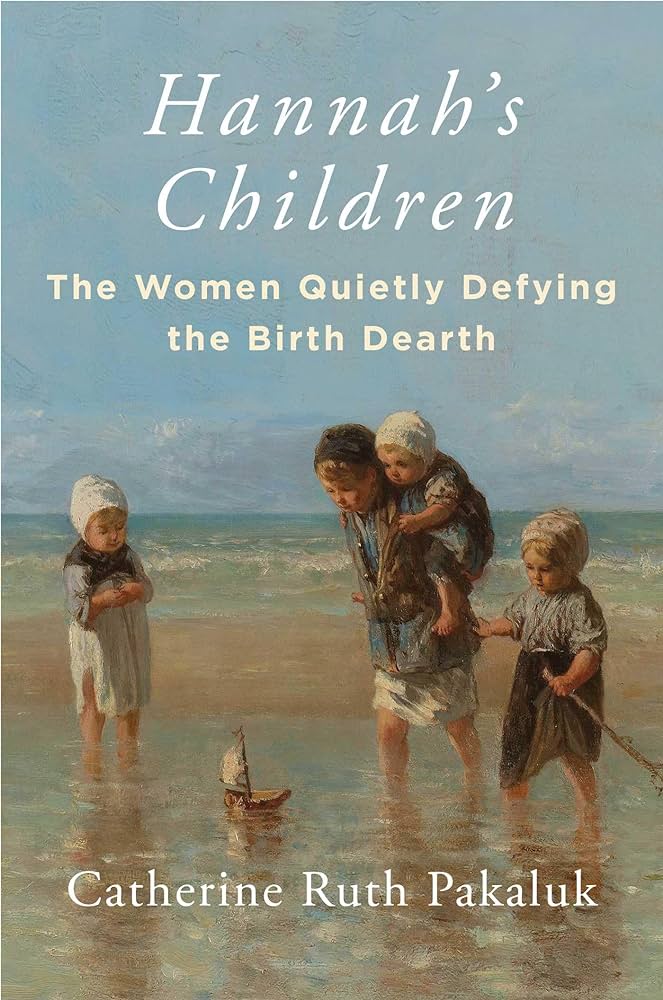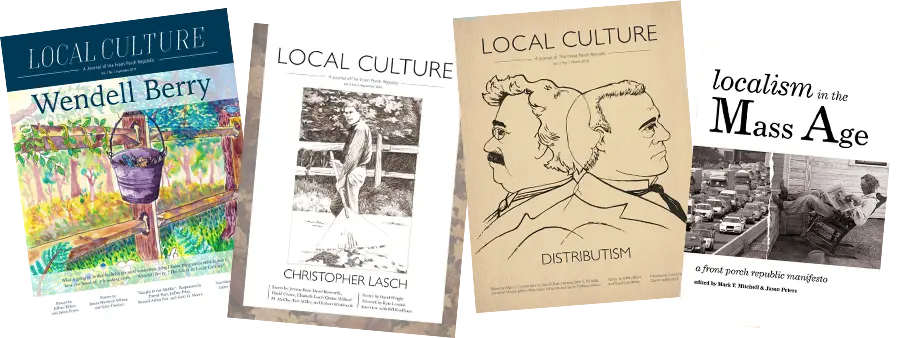Earlier this summer, I arrived at a coffee shop, ready to meet Dr. Catherine Pakaluk, professor of economics, mother of eight, and author of Hannah’s Children. Our meeting got off to a slow start when I failed to recognize her. Given her professional and personal obligations, I was imagining perhaps a buttoned-up business professor or a frazzled working mother, so I was quite surprised when a stylish woman in her late forties approached me and introduced herself as Dr. Pakaluk. I shook her hand and apologized for not recognizing her immediately. She joked, “Not what you expected?”
To be fair, it’s hard to form an accurate expectation about a Harvard-trained economist who is also the mother of eight. In Pakaluk’s case, her intellectual and personal life are symbiotic and well-integrated. She is competent but not proud, analytical but not cold. She speaks in the structured, voluble style of a practiced lecturer, but she is generous with her interlocutor rather than bludgeoning them with pet theories and pontifications.
Hannah’s Children, is the culmination of Pakaluk’s yearslong investigation into why roughly five percent of women are “quietly defying the birth dearth” and choosing to have five or more kids. Her own family life gave her credibility when she would interview these college-educated women who, like her, had bucked the trend, and then her academic training helped shape this qualitative research into something contextualized and compelling.
She found that almost every woman had some kind of religious motivation, and while this may seem unsurprising, its implications are far-reaching. To dismiss Hannah’s Children with a “yeah, yeah, religious people have big families” is to miss the extent of her critique. Her Twitter bio reads “Judith Butler palate cleanse,” and the comparison is apt. Beneath her soft-spoken demeanor is a radical no less than Butler.
Pakaluk has two fundamental contentions. First, we no longer need marriage, children, or the Church. Between the modern welfare state, reliable birth control, and increases in standards of living, we can have comfort, sex, and charity all without the mediating institutions of Church or family. What was once required is now a choice.
Second, our policy debate and discussion of children is fundamentally individualistic and self-focused. Individual subsidies present the decision to have a child as a personal cost-benefit analysis where an extra $2000 might tip the scales. Children are treated as an optional add-on to the bundle of the optimal lives parents seek to craft.
The irony Pakaluk sees is that “many people who are living their lives organized around deeply religious principles go into the public square to talk about policy and pretend as if it doesn’t matter whether people are organizing their lives around religious principles.” Despite their personal experience, they promote individualistic policy.
The fact is, childbearing’s costs fall disproportionately on women. And what comes out in Pakaluk’s research is that these costs are not primarily financial. They are women’s opportunity costs: their loss of status, professional progress, and identity. Religious communities help frame the value of children to counterbalance the costs all women shoulder. Absent living religious communities, raising a large family can seem a foolish investment.
Thus, encouraging religious communities seems to hold more promise than a child tax credit targeted to the individual, but Pakaluk says, “I don’t know anybody out there engaged in criticizing modern individualism who is interested in unwinding the methodological individualism of policymaking.” She’d like to change that.
Hannah’s Children offers a first stab at these knotty questions: What happens when marriage, children, and Church become opt-in rather than the default? Why do some women continue to opt-in despite the immense sacrifice required? And could that be encouraged? Could that spread?
In C.S. Lewis’s essay, “The Decline of Religion” he writes:
It is quite true that chapels which were full in 1900 are empty in 1946. But this change was not gradual. It occurred at the precise moment when chapel ceased to be compulsory. It was not in fact a decline; it was a precipice . . . The withdrawal of compulsion did not create a new religious situation, but only revealed the situation which had long existed.
Although fertility rates didn’t fall precipitously, Pakaluk argues that the Pill and State support have revealed a situation which has long existed: we don’t value children for their own sakes. Birth control made procreation an optional addition to sex. Children no longer supply helpful labor on the front end, and a 401(k) handles things on the back end. So who still has kids, much less five or more kids?
Increasingly, the answer is those who view children as a blessing entirely separate from instrumental reasons. While you can come to value children intrinsically on natural grounds, Pakaluk’s research points to spiritual justifications usually being required. The fertility crisis is a lagging indicator of our spiritual crisis.
But what about all these survey results where women say they want more kids than they end up with? Here, Pakaluk’s economic perspective is a welcome addition to the discussion. She argues that women want more kids in the same way they want to be five pounds lighter. It’s true that they want it, but it’s also demonstrably true that they aren’t willing to accept the trade-offs. Economists generally view people as unconstrained. They don’t let them off the hook. She explained:
Economists are actually tougher on people than philosophers…If it turns out that whatever you say, your choices reflect that you aren’t comfortable with those trade-offs, we actually say you didn’t want it in the first place. We actually say you didn’t have a demand for that thing. Your choices reveal your true demand.
We have lost all the instrumental or unavoidable reasons for having children, and the normative path for women encourages professional obligations that crowd out family life. Given control and options, women’s preferences are being revealed. Pakaluk quips “A pretty good estimation of how many kids you can fit into this two career, modern [life] is 1.6.” 1.6 and trending downward.
Parenthood is hard. No one disputes that. One narrative in the book brings out how parenthood’s challenges are treated differently than professional pursuits. Danielle, a mother of seven, completed medical school and residency and then, after having her first, decided she wanted to stay home with her kids. She reflected:
I feel like there is sort of an implicit notion [when you have a lot of kids] of like, well, “If things are busy you kind of asked for it.” Which is a really interesting contrast to the years of residency, which I also asked for and also made decisions surrounding. But it was always like I felt the overarching vibe was empathy or just more affirmation, like yeah, [medicine] is worthwhile work . . . a worthy choice. It’s consuming but worthy. [With kids], it’s sort of like, “Well, it’s your life.”
I asked Dr. Pakaluk about this specific phenomenon. We can all agree that difficult things require sacrifice. Why is it that we focus on the upside with professional life and the downside with family life? She replied:
We don’t think having children is valuable or worthwhile . . . We don’t value medicine and bootcamp and the military—these other all-encompassing professions—we don’t value them because they’re costly or because they’re hard. There’s all kinds of things that are hard to do that we don’t value . . . To say something completely absurd for a minute, try to live a functional life as an alcoholic. It’s actually very difficult. There’s an intense level of willingness to suffer . . . but we don’t value living as an alcoholic. I don’t want to make light of an addiction, but I’m drawing it out. We have no difficulty separating out costs that people willingly take on to do something foolish . . . from the inherent value of the thing. The question is why we don’t value children and childbearing. They are as hard as medicine and the military and climbing a high mountain, but we don’t see them as worth doing.
This is the crux of Pakaluk’s argument. It’s hard for women to prioritize family at the expense of professional accomplishments, recognition, and camaraderie. It’s especially hard to do that when your colleagues don’t view family life as a meaningful commitment. These women who chose big families aren’t acting irrationally. They aren’t brainwashed. They are faced with the same trade-offs as other women, but when they consider the upside, the blessing of another child, they have more weight on that end of the scale than their secular counterparts. They value children more.
There’s a new book out entitled What Are Children For?, and in many ways, it’s doing for the Left what Brad Wilcox’s book Get Married did for the Right. Both seek to debunk popular narratives about why you shouldn’t marry and have children. The Left is concerned with climate change, autonomy, and precarious financial conditions. The Right is more concerned with toxic femininity, precarious divorce laws, and all manner of leftwing Psy Ops. And while both books provide valid arguments, which Pakaluk acknowledges, she points out, “An interesting question is, ‘Would anyone get married because it’s a good deal?’”
She likens family life today to cold plunges. You may be able to point to data and make a case for why cold exposure should be part of your life. But what actually makes people jump in? She elaborated:
When you take a whole bunch of hard things and put them in the opt-in category, now you require a type of virtue that typically is produced by opting in. You have to be in that state to have the kind of virtue that will say, “Yeah, I’ll jump in that again” . . . You hear this all the time. “I’m not even responsible enough to have a dog. I’ll wait til I grow up to have a child.” And you’re like, “But if you don’t have the child, you won’t grow up. That’s how you grow up.”
People do not “jump in” to family life for $2000. In fact, given women’s steadily increasing earning potential, any child tax credit increase is likely a laughable sum compared to their foregone income. At most, these programs encourage those already planning to have kids to shift their timing and cash in. They don’t result in more lifetime births. Pakaluk writes: “It has been the universal observation of political economists and historians that fertility cannot be encouraged by policy, even if it can be very successfully discouraged.”
Instead, people jump in because they are part of living religious communities that provide “plausibility structures,” encouragement, and support. They are surrounded by people who make it seem both possible and admirable. Pakaluk’s goal to shift family policy from incentivizing individuals to incentivizing living religious communities is what she calls “Freeing the Temple.” Because that’s where the change occurs in women’s considerations, that’s what actually moves the needle.
Pakaluk describes how mothers of large families move beyond the language of accomplishment and the narratives of self-identity that we are all immersed in. Of course, you can still have children because you’re a “pro-life person” or a “conservative” or because you want to be a Mom, but Pakaluk is quick to distinguish between the language of accomplishment that focuses on self-actualization and the language of blessing and gratitude when it comes to children.
She explains, “We’re human and when we do hard things we take pride in them. And that’s a good thing. But what I wanted to highlight is that there’s another attitude, this attitude of a kind of selfless enjoyment of the other, which is very special and it’s I think quite different.” Pakaluk found that mothers of large families, if they didn’t start this way, ended up this way.
She went on:
There’s a subtle point here, which is a little bit hard to say. When we want a little bit of kids and a little bit of profession, that’s a sort of choosing about “what’s the bundle, what’s the mixture of family and work that is going to realize my vision of myself?” We’re still valuing kids instrumentally . . . Can we resolve the tension between children and self-identity absent a source of intrinsic value for children? . . . I don’t think so.
In many ways, Pakaluk sees herself and her center-left critics as largely in agreement. Motherhood does indeed require dying to self and huge professional sacrifices. Within a Christian framework, self-abnegation is an aid on the path to sainthood. Indeed, the attention kids demand can become the source of great joy and freedom from a shallow, self-focused life. Absent this spiritual insight though, it’s quite understandable that you’d view children as a burden and imposition.
On the one hand, a cynic might note that these mothers of five or more are statistically insignificant. Demographer Lyman Stone showed that this cohort could double and it wouldn’t dramatically alter the birth rate. And that’s true, but it misses the point. If what separates these women is not a fluke but a spiritual conviction, then there’s no reason to say this couldn’t spill over. Pakaluk is saying we need a revival, a Great Awakening—something America has seen before and could again.
C.S. Lewis diagnosed nearly a hundred years ago that “something that may be called ‘a decline’ and something that may be called ‘a revival’ are both going on.” Today, there is much hand-wringing over young people abandoning church and latching onto harmful substitutions for religion. Clearly, that is happening. There is also a trend, one I’ve seen personally, of young people seeking traditional, rigorous forms of worship.
American Christianity is full of doomers, ready to circle the wagons and let the country go to hell, but Pakaluk is hopeful: “The narrative here is that this is a steady march of modernity or progress, but then if you look around, you go, ‘But there’s people all over the place breaking out of this and could more of that happen?’ Of course more of that could happen!”
So Pakaluk wants to start new debates. Are there ways government can incentivize religious communities? Would school choice be more effective than a child tax credit? What does it mean that during COVID, churches were deemed less necessary than liquor stores? If charity has been relocated from the Church to the State, what might happen if the material mission of the Church was restored alongside the spiritual mission?
These are provocative questions. They raise all sorts of issues of political practicality, and she admits she doesn’t have bills ready to introduce (though she is clear that she’s not advocating for some Integralist Utopia). But frankly, considering our national debt will be pushing 50 trillion before too long, I am open to creative solutions rather than mere increases in subsidies and credits.
In interviews (mine included), Pakaluk often mentions one son who got married and started a family at age twenty, and two other sons who are walking a similar path. The witness of young married parents may well be both a more practical and effective means to raise the fertility rate, and those families are quite often a product of a religious milieu. Without God, a spiraling fertility rate seems certain. But on spiritual grounds, there’s always room for hope and renewal. When the seed is sown on the good soil, it bears thirty, sixty, and a hundredfold.
How can our society produce more good soil? Perhaps that will be Pakaluk’s next book.
Image Credit: Sébastien Bourdon, “The Holy Family” (mid 17th century) via Flickr






3 comments
Tory Baucum
Good review Ben! You write well. Catherine will be a keynoter at our national symposium on marriage and family in March 2025!
Madeleine
Great article, thank you!
Patrick Pellerin
This is a great article and I will refer it to others. Thank you for sharing
Comments are closed.